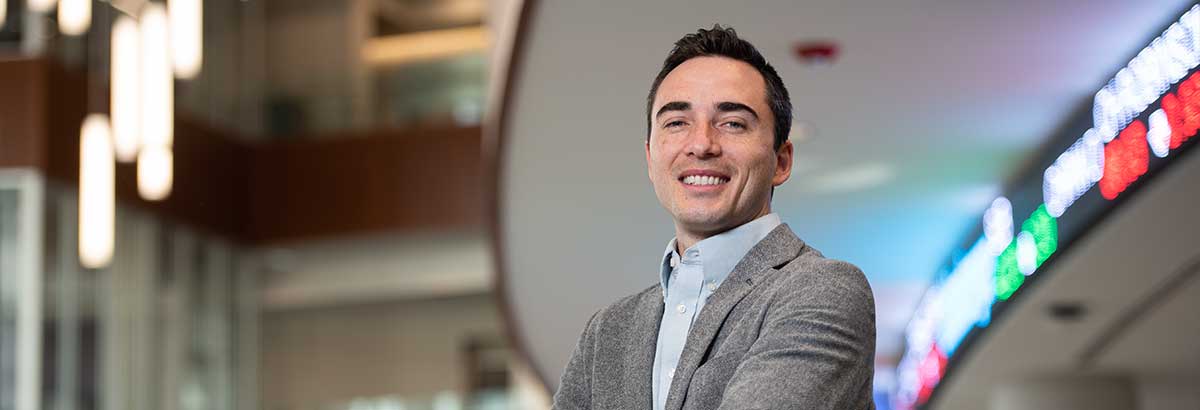Analyzing the ever-changing economy
The new normal
By Courtney Roszak-Moore
Resilient. Adaptable. Unpredictable. Economists have used many of these words to describe the state of the economy since the COVID-19 pandemic began more than two years ago. The economy has faced countless hurdles, and no one knows when — or if — it will return to normal.
Kansas State University researchers say the economy’s struggle to normalize is a result of a chain reaction that involves the workforce, inflation and supply and demand. It’s a volatile cycle that has been felt across the 105 counties of Kansas and throughout the country and world.
The economy is a broad term that is all-encompassing. Broken down, the economy is a result of what every person produces and is driven by two factors: the ability to have a job and how much goods cost. To have a growing economy, society needs a strong and sustainable overall growth rate, but when growth is not sustained, it creates uncertainty.
That uncertainty motivates several K-State researchers across colleges to analyze what is going on with the ever-changing economy and to offer some hope for the future.
What happened?
Flip the calendar back to March 2020. Economic activity went to zero and the country experienced a shutdown. Unemployment rose and people stayed home and didn’t go about their normal routine of buying things. To try and rebound the economy, the Federal Reserve issued several rounds of stimulus checks.
“The economic decisions that we saw in March 2020 were driven completely by the fact that we were shut down,” said Eric Higgins, research director and the von Waaden Chair of Investment Management in the College of Business Administration. “Once the country opened back up, those issues began to go away and the economy came back.”
Fast forward two-plus years. Every day we hear about inflation, unemployment and the volatile market. The economy is experiencing an increased labor shortage because of retirements or decisions not to return to the workforce, Higgins said.
But Higgins wanted to know: Is the economy really bad or are we still experiencing the aftereffects of March 2020?
Higgins and several collaborators tried to find the answers by analyzing and comparing 2020 to the 2008 Great Recession. Their research shows that 2020 was not a repeat recession, but was the result of financial issues and decisions directly correlated to the pandemic. As businesses began to reopen and people left their houses, we began to see increased growth and demand for products.
“If there is a shortage of labor and people want to purchase things, that means the price of labor is going to go up and the price of stuff is going to go up,” Higgins said. “The economy isn’t bad. I think the economy has rebounded, but it hasn’t normalized in terms of what the new normal looks like and that might take a while.”
Words to know
Kansas State University researchers define commonly used words associated with the economy.
Economy
What everybody produces. The economy is driven by two forces: the ability to get a job and how much the goods being produced will cost.
The market
Where commodities are purchased or sold, also known as the stock market. The market moves up or down and is influenced by a variety of events and numbers, including inflation.
Inflation
The overall increase in the price level on an annual basis. The Bureau of Labor Statistics collects several different measurements of inflation every month, but the one that’s most often cited is the consumer price index.
Great Resignation
An ongoing phenomenon of employees quitting their jobs during the COVID-19 pandemic for a variety of reasons.
Job design
How organizations create a job. It includes aspects such as the supervisor, the co-workers, the assigned tasks, the workspace location and an employee’s title.
Supply chain
The relationship between supply and demand. It’s the process of how a product goes from an idea to a good that is purchased.
The role of inflation
Consumers are feeling part of the new normal when they buy goods at the store and see increased price tags, driven by the highest level of inflation in decades.
Daniel Kuester, director of economic undergraduate studies in the College of Arts and Sciences, has taught courses on the principles of microeconomics and macroeconomics for years.
“Today, people are aware of inflation, and once people become aware of it, and they think about it, they start to forecast it out in their heads and it starts to become self-fulfilling,” Kuester said.
Inflation looks at the rate of change in the overall price level on an annual basis. The price of an item can increase or decrease depending on several components, including supply chain factors, the response to a global pandemic and monetary policy, among other factors, Kuester said.
“If you have the same number of goods being produced and you double the money supply and nothing else changes, prices will eventually double,” Kuester said.
Thomas Kelemen, assistant professor of management, studies how job design influences an organization’s retention rate.
Out of the office
The Great Resignation is an ongoing phenomenon where employees have been leaving their jobs during the pandemic for a variety of reasons. One of those reasons, according to Thomas Kelemen, assistant professor of management in the College of Business Administration, is job design.
“Job design is how organizations construct an employee’s position, which includes their supervisor, co-workers, the tasks they are assigned, dressing policies and the physical space that they’re working in,” Kelemen said. “It’s a pretty broad term and it kind of encompasses all aspects of how the organization creates the job for employees.”
The COVID-19 pandemic changed the layout of the job force — it taught employers flexibility and that employees could be productive from home.
Kelemen’s own research shows that organizations must look at how to design jobs so that potential employees want to work for them. As organizations start to make changes, it can cause a domino effect in industries.
“I think organizations are going to have to look at lots of different things — how can we attract employees or what is attractive to employees,” Kelemen said. “Maybe we had the Great Resignation, so now, what might be coming is the Great Hiring. People are likely going to come back to work. The question is what have organizations learned and are they going to apply that learning to design their jobs to better match what employees want?”
Kelemen recently published in the Harvard Business Review and the Journal of Organizational Behavior for his work on nonstandard business hours.
Decisions, decisions
The economy, inflation and resignations all connect to supply and demand. The relationship between supply and demand is described with an all-too-familiar term: supply chain.

Left: Ashesh Kumar Sinha researches how labor shortages in transportation affects the supply chain.
Ashesh Kumar Sinha, assistant professor of industrial and manufacturing systems engineering in the Carl R. Ice College of Engineering, researches the supply chain in manufacturing and transportation — one of the hardest-hit industries experiencing labor shortages. Sinha has been studying how the job design of a truck driver plays a part in the supply chain.
“If a single driver quits, disruptions occur to the entire network, not just in one area,” Sinha said. “Today, drivers are quitting because of the demands of being on the road all the time. To help with this issue, the logistics and planners need to find a way that the drivers won’t be away from home as much.”
Sinha is partnering with the grain science and industry department in the College of Agriculture on a U.S. Department of Agriculture grant focusing on the supply chain. From 2017-2020 he collaborated with Schneider National, a logistics firm, to research different ways to improve current operations.
Another related, but different, supply chain issue involves the public health sector, which was slammed with an increase in demand for products in March 2020. Jessica Heier Stamm, associate professor of industrial and manufacturing systems engineering, uses mathematical models to represent supply chain systems and improve the decision-making process.
The public health supply chain differs from consumer chains because uncertainty, urgency and decentralization in decision-making increase complexity. Heier Stamm said this provides an opportunity for researchers to account for these factors in their modeling. Insights from the models can help build more robust, resilient systems to ensure communities have enough supply to meet demand.
“It is really looking at what are all of these scenarios and what capabilities do we need to build,” said Heier Stamm, a Gisela and Warren Kennedy Cornerstone teaching scholar and a Steve Hsu Keystone research scholar. “In reality, we can talk about preparedness all day, but until we build some of these practices into the everyday operations of our systems they won’t stick, which is a big ask.”
Heier Stamm is partnering with the Kansas Department of Health and Environment Preparedness Program, which focuses on supply chain integrity. She also is leading a National Science Foundation project on the impact of the public health supply chain coordination structure on the effectiveness of disaster preparedness.
